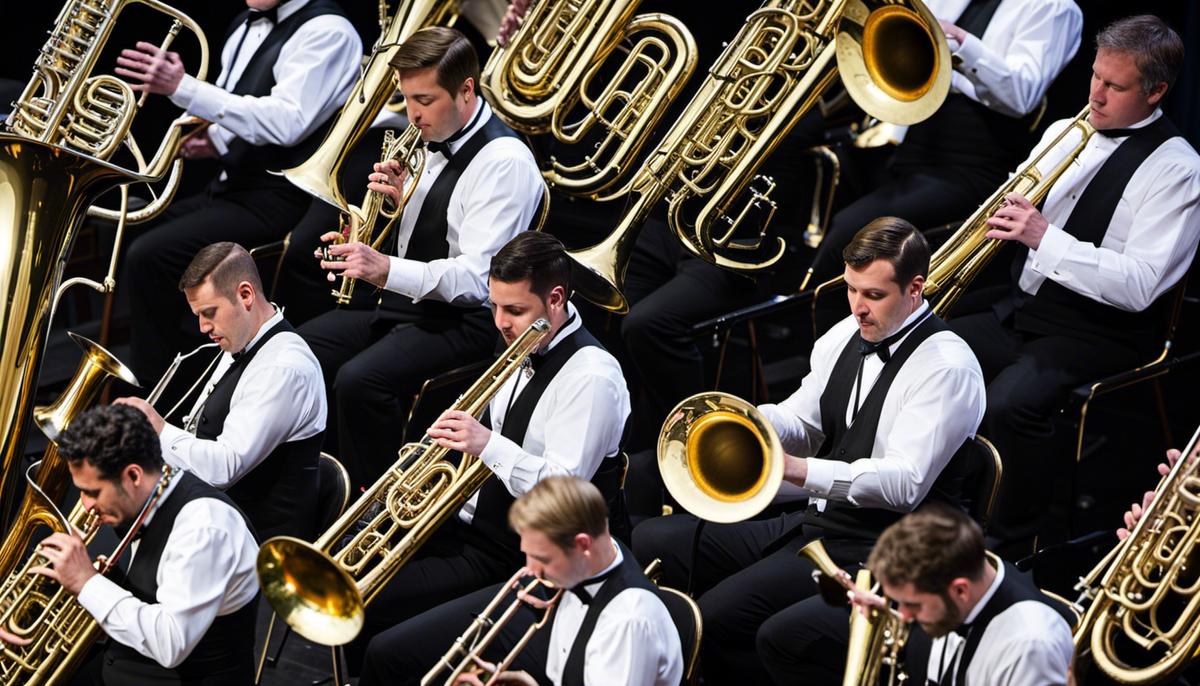Table of Contents
Introduction
There are countless great low brass ensembles offers a transcendent auditory adventure, full of rich tones, compelling harmonies, and intricate teamwork. This journey begins by understanding the fundamentals of the main low brass instruments such as the trombone, tuba, and euphonium.
Appreciating their unique mechanics and sound qualities lays the foundation for a deeper exploration. Moving forward, we trace the evolution of low brass ensembles across history, identifying key historical periods and compositions that have shaped the format. Learning the essential techniques for performing in such ensembles while highlighting the team dynamics further fortifies our understanding. Lastly, reflecting on the successes of renowned low brass ensembles around the globe, provides invaluable lessons for aspiring enthusiasts and hobbyists alike.
Understanding Low Brass Instruments
Understanding Low Brass Instruments: Conception and Mechanics
Low brass instruments comprise a distinct segment of the brass family. These instruments, which include the trombone, tuba, and euphonium, are characterized by their deep, rich tonal range. They are usually constructed from brass and played by blowing air through closed lips to produce a “buzzing” sound that starts a standing wave vibration in the air column inside the instrument.
The trombone, known for its unique slide mechanism, allows for a wider variety of pitches produced in rapid succession as compared to other brass instruments. By contrast, the tuba, the largest instrument in the brass family, has a deep, resonant sound. It is used to play the bass line in a musical arrangement and often plays a critical role in establishing the piece’s rhythm.
The euphonium, while similar in shape to the tuba, is notably smaller and has a brighter and mellower tone. Euphonium players are often tasked with playing both harmonic structures and solo performances within the ensemble.
Distinctive Sound Qualities of Low Brass Instruments
In terms of sound qualities, low brass instruments are often lauded for their mellow yet profoundly resonant tone. The trombone can produce a rich and varied sonic palette, which can range from aggressively vibrant to soulfully melodic. Additionally, its unique slide mechanism allows for smooth glissandos, a feature that sets it apart from other brass instruments.
The tuba’s deep bass sound anchors the harmony in an ensemble and provides a solid foundation for the group’s sound. Its vast range allows it to take on roles traditionally reserved for bass and percussion instruments.
The euphonium, on the other hand, is praised for its warm, lyrical tone. Its range is comparable to that of the trombone, and it is capable of both powerful fanfares and soft, melodic lines.
Role of Instruments in a Low Brass Ensemble
In a low brass ensemble, the trombone, tuba, and euphonium each play key roles. The trombone often takes on the melody or is assigned important countermelodies. Because of its unique slide mechanism and wide range of pitch, it provides a bridge between the highest and lowest instruments in the ensemble.
The tuba primarily provides rhythmic and harmonic support. By playing the bass lines, the tuba helps to underpin the group’s harmonic structure and rhythm, driving the music forward.
The euphonium is a versatile instrument in the ensemble. It often plays an accompaniment role, filling in the chords and adding depth and richness to the harmony. However, due to its beautiful tone, it is also an excellent solo instrument and is often featured prominently in ensemble pieces.
For those with a passion for low brass ensemble performance aspiring to master the art, it’s thoroughly essential to comprehend the role of their particular instrument. Understanding how your instrument contributes to the harmony of the group’s overall sound is fundamental.
History and Evolution of Low Brass Ensembles
The Birth of Low Brass Ensembles
Delving into the origins of low brass ensembles, we find ourselves taken back to the Renaissance and Baroque periods, a time when adventuring with a myriad of wind instruments became a musical trend. Of all the brass instruments, the trumpet held the spotlight in many ensembles. As we venture into the latter part of the 19th century, we see a growth in the popularity of lower brass instruments such as the trombone, euphonium, and tuba. This expansion can largely be attributed to the transformations within military bands and concert performances, which were among the pioneering groups to incorporate low brass instruments into their lineups.
The Classical Era and Low Brass
In the Classical Era, the amalgamation of low brass instruments into orchestral compositions remained limited. Notable exceptions include Mozart’s “Requiem Mass,” which utilized trombones. The famed composer Beethoven infused trombones into his compositions later in his career, notably in his Symphony No.5 and Symphony No.9.
Low Brass in Romantic and Modern Era
As the Classical Era gave way to the Romantic Era, composers began to explore the expressive capabilities of low brass instruments. Notably, Richard Wagner incorporated low brass into his monumental operas, and Gustav Mahler featured the tuba and euphonium in his orchestral works. Johannes Brahms too utilized the trombone in his Symphony No. 1. In the Modern Era, innovative interpretations of low brass ensembles have continued to emerge.
Composers like Stravinsky, Shostakovich, and Prokofiev brought more prominence to low brass instruments, often using them to evoke dramatic, solemn, and emotionally charged moments in their pieces.
Popularity of Low Brass Ensembles
Another key factor in the rise of low brass ensembles was the development of the American school band movement of the early 20th century. The popularity of bands in educational institutions dramatically increased the demand for all brass instruments, particularly the lower brass. In more recent times, popular music, particularly jazz, has embraced the use of low brass instruments. These factors brought about a rise in nontraditional low brass ensembles, like the trombone choir and tuba quartet, significantly impacting the perception and prominence of low brass instruments.
Present-Day Prominence of Low Brass Ensembles
The current musical landscape bestows an esteemed recognition on low brass ensembles, with their pivotal role in a myriad of music genres, including classical, popular, jazz and film music. The escalated diversity of these ensembles, their adopted styles, and performed compositions speak of the intrepid trials and endeavors by composers and musicians over several decades.
The utilization of low brass by Charles Ives to accentuate a somber mood in “The Unanswered Question,” as well as John Williams’ memorable low brass scoring in film scores such as Harry Potter and Star Wars, epitomize the success narrative of low brass ensembles. This historical account is reflective of a continuous evolution and innovation in articulating these instruments.
Techniques and Performance practice in Low Brass Ensembles
Mastering Core Techniques of Low Brass Instrumentation in an Ensemble Setting
In relation to low brass ensembles, mastering specific techniques form the cornerstone for executing the correct tones, ensuring accurate intonation, and achieving precise articulation.
The production of tone in low brass instruments leans heavily on elements like breath support, embouchure, and an understanding of the instrument’s mechanics. To produce sound, a substantial force of air, regulated by the diaphragm, is indispensable. The formation of facial muscles and lips when playing, known as the embouchure, is also crucial. Furthermore, a foundational grasp on your instrument’s mechanical workings helps in attaining the finest sound quality.
Articulation techniques primarily deal with how notes are initiated and ended. Musicians maneuver their tongue placement and air pressure to generate sharp staccato notes or seamless legato phrases. These articulation techniques enable musicians to proficiently maneuver through a broad spectrum of pieces embodying diverse styles and moods.
Maintaining correct pitch, or intonation, when playing a low brass instrument is paramount, especially within an ensemble. Successful intonation promotes a harmonious group performance. It necessitates attentive listening and ongoing adjustments, as pitch can easily be influenced by factors such as the temperature of the instrument or the applied technique.
The Importance of Team Dynamics in Low Brass Ensembles
Mastering a low brass instrument requires more than technical aptitude – it is equally pivotal to grasp the principles of the ensemble’s team dynamics. In essence, comprehension of leadership roles, along with fostering robust musical communication among the players, is crucial.
Within a low brass ensemble, the chain of command often rests with the conductor and the section leaders. Their role is integral in maintaining the ensemble’s harmony, making certain that tempo, dynamics and style are consistent across the board. Additionally, they shoulder the responsibility of tackling any challenges that emerge during performances or rehearsals.
While leadership is crucial, the contribution of every member is instrumental in achieving the desired level of coordination and harmony within an ensemble. Mutual cooperation and effective communication are pivotal in sculpting a coherent and unified sound. Musicians are expected to listen attentively to their co-performers and tweak their performances accordingly.
The exchange of musical ideas among players, or the ‘musical dialogue’, is an intriguing facet of ensemble performances. This exchange traverses past simple coordination, instead dwelling in the sphere of collectively illustrating the mood, message or narrative implicit in the music. This demands a deep understanding of musical structure and content, mirrored in the performers’ playing.
Ultimately, honing specific techniques and learning to engage harmoniously with the team can significantly magnify your musical experience within a low brass ensemble. This blend of skills will enable you to craft emotionally resonant and captivating performances that leave a stirring impact on audiences.
Exploring Famous Low Brass Ensembles
Boston Symphony Orchestra – A Stalwart of Low Brass Ensembles
The Boston Symphony Orchestra bestrides a prodigious reputation, hinging enormously on the brilliance of its low brass section. Housing virtuoso trombonists and tubists like Toby Oft and Mike Roylance, the ensemble offers performances celebrated for their lyrical sophistication. Their signature amalgamation of ensemble depth and individualistic flair yields musical spectacles that are detailed and balanced, thus exquisitely showcasing the low tonal range. Additionally, they have become luminaries in the realm of academia as many are esteemed faculty members in prestigious institutions, thus crafting the coming generations of low brass musicians.
Mnozil Brass
Mnozil Brass, an Austrian brass septet, is another ensemble that has achieved worldwide recognition. Their blend of virtuosic brass playing and theatrical humor offers a unique performance style that is both engaging and technically impressive. With their innovative routines often building around classical music pieces, but also venturing into jazz and other genres, they push the creative boundaries of the low brass repertoire. They have had a significant impact on the popularity and visibility of brass ensembles, both in traditional concert settings and in viral YouTube videos.
The Chicago Symphony Orchestra Low Brass Section
Considered to be one of the most influential in the world, the Low Brass section of The Chicago Symphony Orchestra is known for its sonorous and resonant sound. Legendary musicians such as Jay Friedman, Michael Mulcahy, and Charles Vernon form a part of this brass powerhouse. With a repertoire ranging from classic symphonies to film scores, their control and dynamic range are often used as a benchmark for other ensembles. Their performance style emphasizes the harmony of the ensemble without diminishing the individual impact of each player.
German Brass
German Brass encompasses a wide repertoire ranging from baroque to contemporary works. Comprised of top-ranking German musicians, the ensemble is recognized for its precision and unity, leading to dynamic performances that are as technically impressive as they are emotionally compelling. The group regularly organizes master classes and workshops for both students and professionals, thus extending their influence on the world of low brass ensembles from performance stages to classrooms.
The Atlantic Brass Quintet
With nearly three decades of performing experience, The Atlantic Brass Quintet is one of the world’s finest and most celebrated ensembles. Known for their energetic performances and broad range of styles, the Quintet has introduced numerous world premieres and original compositions to their repertoire, setting a precedent for innovation in the low brass ensemble world. The Quintet’s educational activities include an annual Summer Seminar, teaming up with educational institutions offering masterclasses and intensive coaching sessions to young musicians.
These low brass ensembles, with their varied repertoire, performance styles, and educational initiatives, have significantly impacted the global brass community. They serve as invaluable examples for musicians wishing to delve deeper into the world of low brass ensemble performance.

Conclusion
Embedded in the orchestral soul, the low brass ensemble breathes life and depth into any composition. From the heart-felt tones of the trombone to the profound resonances of the tuba, and the distinct euphonium voice, this family of instruments sings in unison to create a compelling musical narrative. Grasping their function and role in an ensemble paints a picture of the complex but rewarding teamwork dynamics involved.
Delving into their historical evolution reveals a rich tapestry of cultural context and musical progress. And finally, celebrating the acclaimed low brass ensembles around the world amplifies the impact they have in the sphere of music and provides inspiration for enthusiasts to further hone their skills and pursue their passion.
Additional Reading
Take some time to check out our other articles:
Breve Music Studios publishes music to Spotify, YouTube Music, Amazon Music and more. Follow our pages on Facebook, Instagram, Twitter, TikTok, and YouTube.
Listen to our ensembles: Breve Orchestra, Breve Music Ensemble, Breve Low Brass Ensemble, Breve Woodwind Ensemble, and Jermaine Harris on Spotify.

